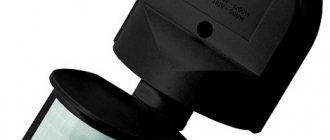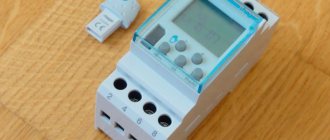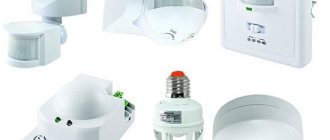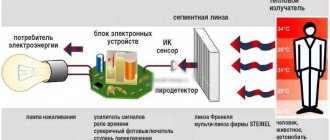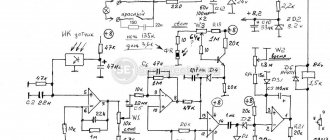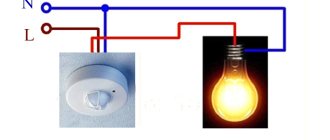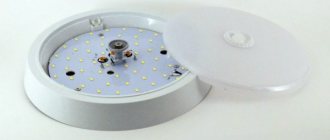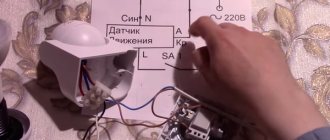Motion sensors for alarms, called infrared detectors, are the main element of the internal protection of a security alarm system. Infrared detectors operate on the principle of changing thermal radiation from the infrared range using a pyroelectric sensor, the electrical signal of which is analyzed by a special electronic circuit of the detector. This type of device does not emit its own energy and is battery-powered, ensuring that any change in infrared radiation in their field of view is accurately detected.
How does a motion sensor work for lighting and its design, what the user needs to know about
Just imagine that you no longer have to look for the light switch in the dark to get to the toilet or kitchen. The system will do everything itself. When a person appears in the visibility zone, the sensor is triggered, lighting the lamp attached to him. This process takes a few seconds: the device closes a circuit through which voltage is supplied to a light bulb or group of lamps indoors or outdoors. Most motion sensors have several options that make it convenient to control:
- setting the time interval for lighting activation;
- sensitivity adjustment (needed so that the device does not react to the movement of pets);
- illumination zone.
Diagram of the design and operation of an infrared motion sensor. Please note that the device responds to a thermal emitter
GOOD TO KNOW!
It is better not to use such devices in the bathroom or toilet, otherwise you will often have to wave your hands to trigger the sensor and keep the room illuminated.
How the technology works
Infrared remote detectors using QUAD technology have four pyroelectric detectors. They are located differently. As standard, they are installed next to each other, which allows four detection zones using one Fresnel lens or one mirror. However, a much more commonly used arrangement for pyroelectric devices today is to arrange them in two rows of two detectors.
Thanks to this arrangement, the detection zones are grouped into groups of four beams. Looking at the diagram above, it can be concluded that QUAD detectors have two detectors with dual pyroelectric sensors. In infrared detectors with QUAD technology, the electrical signal from each pair of pyroelectrics is processed separately in an analog-to-digital chip.
Types of motion sensors and their main features
A great way to protect yourself and your home from unwanted visits from scammers is to install a motion sensor on your lighting. However, first you need to understand the types and their principles of action.
Outdoor infrared motion sensor for turning off lights - sensitive to any movement
Infrared DD is capable of saving energy, preserving the service life of the lighting. This type of device is triggered exclusively by thermal movement, that is, if the objects of movement are animals, people or a running vehicle. Using touch lenses, the device receives a signal and activates the lighting. The coverage area of the DD (motion sensor) depends on the area where the lenses are placed. The device has several disadvantages:
- often triggered by a warm wind;
- does not see a person if he puts on material that reflects heat;
- reacts poorly in wet and rainy weather.
Infrared DD is harmless to humans and animals, as it does not emit specific signals that irritate the body.
Ultrasonic sensors are suitable for entrances in apartment buildings and lamps in apartments
The occurrence of dust and humidity does not affect the performance of the device in any conditions. It is better not to use such structures in your yard or house. The fact is that the device is capable of responding to sudden movements. If you smoothly walk past the device, then the DD will not work. This device is not safe for pets, because they perceive ultrasound. Has several disadvantages:
- low response area;
- sensitive to mechanical stress;
- triggers with any movement (which is inconvenient).
The difference in air temperature around the ultrasonic DD is not an obstacle to its performance.
Security motion sensors, or microwave DD
Despite its small size, the DD is able to respond to movements with minimal activity. The microwave motion sensor is capable of emitting electromagnetic waves, which, when reflected from a moving object, trigger the touch panel, and it, in turn, activates a given function (siren, lighting). The disadvantages of this design are:
- expensive;
- dangerous to human health as they emit high power microwaves;
- false alarm (if the object moves outside the yard gate).
The device has proven itself to be excellent for security purposes: it is able to respond to body movements behind glass walls, without being triggered by changes in air temperature.
Combined universal motion sensor
Combined models are so practical that they are suitable for installation indoors and outdoors. They do not respond to the climatic state of the environment. Combined motion-sensing devices contain several technologies that trigger simultaneously. If the ultrasound method is unproductive, then it will be replaced by infrared radiation. In the DD, microwave and ultrasound or IR and ultrasound can operate simultaneously.
Motion sensors for LED lamps: what is their difference
Before purchasing a device, be sure to check the conditions under which it can be used. It is known that LED light bulbs are the most economical lighting sources; accordingly, not all LEDs are suitable for them. Infrared sensor devices are suitable for these conditions. Their operating range is 3 meters, and such installations are intended only for LED strips. The devices have less power than traditional devices. Among the disadvantages it is worth highlighting:
- high cost;
- small area coverage;
- demanding to use.
Features of lamps with a motion sensor for entrances
The lamp combined with a motion sensor is an alternative to hopeless incandescent lamps. New devices are able to control the voltage supply to turn on the lights the moment a moving object is noticed. Using this device you will be able to significantly increase the life of the light bulb.
Optical systems of infrared detectors
Infrared detectors for home and garden are equipped with special optical systems, the task of which is to concentrate infrared radiation on the pyroelectric sensor. There are two main optical systems: based on mirror technology or Fresnel lenses.
Analyzing both systems from the point of view of their ability to detect an intruder, we can conclude that they are equal, and each of them has certain advantages and disadvantages. Manufacturers are striving to create optical systems whose design would allow an image to be produced on a plate in the form of a dot. Of course, in practice it is impossible to create an optical system with such a property. Today, a sufficient solution is to reduce the volumetric radiation beam to the size of the detector plate.
Most often you will encounter infrared detectors built on the basis of wide-angle lenses, which allow you to obtain a field of view from 90 to 130 degrees. The range of such detectors ranges from 12 to 15 meters.
Practical advice on how to choose a DD installation area
Before installation, you should decide on the best place to place the device. After all, how correctly the device will work depends on this moment. Depending on this, a wall or ceiling motion sensor can be used. It is ideal to place the device so that its trigger mechanism is directed towards the door to the room. Also pay attention to the diagram below, which details where the motion sensor will see movement and where it will not: To accurately trigger the motion sensor without failure, you need to adhere to the height of its placement. It must be at least 2.5 m
- First of all, it is necessary to prevent false alarms of the device. Do not install the device opposite a window; it is better to choose a corner area.
- You should not install the motion sensor next to heat mains or heating devices; they also emit heat and can cause the lighting to work constantly.
- It is better not to place this device in a kitchen that has a microwave. Household appliances will interfere with the performance of the device.
HELPFUL INFORMATION!
To connect the light detector there is no need to make additional cable routing in the electrical distribution box. You can connect the device to the network using a plug with a wire through a socket.
Criterias of choice
Weather resistance
According to safety requirements, the housing must provide protection of electronic components from dust and solid particles of at least level 4 protection. Protection against moisture penetration is calculated at less than level 6.
For home use, it is enough to have devices that meet the IP44 and IP54 protection levels, which provides protection from dust and splashing water.
Reaction to external factors
Active detectors must be protected from electromagnetic radiation; for passive detectors, the reliability criterion is the protection factor relative to the reaction to pets.
Purpose
All types of devices are applicable for internal production and warehouse premises; for premises in which personnel may be present, the exception is ultrasonic sensors.
Appearance
Devices are selected for open or hidden installation. Open placement should provide an aesthetic appearance, and with hidden installation, compact housing and cable lines.
What is important to consider before connecting a motion sensor
There are several important points that you need to know before putting the device into operation. Let's look at it in detail in the table.
| Illustration | Parameter | Description |
| Viewing angle | Typically, the problem of determining the response zone is characterized by wall-mounted models of regulators. You will have to choose a tilt angle in the range of 15-50°. Otherwise, check the operation of the device every time you turn it. | |
| Device sensitivity | Using the adjustment lever, you adjust the desired sensitivity threshold. To begin with, set the value to min and check how the device works for all family members; if this is not enough, increase the value a little and check again. | |
| Response time | There is also a knob for this option, designated TIME. The time threshold in these devices is 3−15 seconds. You need to set yourself the desired indicator, that is, adjust this parameter to suit you. | |
| Area illumination level | It is important to configure the motion relay correctly here. It is better to do this in the daytime, and in the evening just reduce the level of illumination until the sensor starts to work. The regulator is designated LUX. |
NOTE!
There is no need to disassemble the motion sensor in search of the LUX adjustment lever; on some models it simply does not exist. Therefore, first determine the functionality of the light detector.
Correct connection diagram for a motion sensor for lighting: two connection options
There are several options for connecting motion sensors that regulate lighting in a room or yard. You can connect several sensors to the lighting system or just one, and also organize the operation of the detector in conjunction with a switch.
Method for connecting one or more motion sensors for light
Wire switching can be done in two different ways in accordance with a specific circuit. Using this diagram, you will make an error-free connection of the light detector. Most models of motion sensors have three terminals for connecting conductors. To connect the power circuit, you need to use pins L and N.
The devices also have a Lout terminal - this is the second part of the contact connection, which is connected to the L terminal, as shown in the diagram. Thus, it can be seen that the connection of the motion sensor occurs by breaking the electrical circuit coming to the lamp. If you plan to use two or more sensor devices, then they must be connected in series.
Connecting conductors when installing a motion sensor with a switch
For this method, a separate circuit is used, which provides for connecting a motion sensor, lighting and switch in parallel. Pay attention to the photo below. Connection diagram for a DD with a switch In this case, zero and phase come from the electrical panel to the distribution box. From here the neutral conductor goes to the detector and to the lamp. The phase is connected to the DD phase and returns to the switch contact, after which it leaves it, returning to the distribution box, where it is connected to the red wire of the sensor device.
The switched wire goes to the contact of the light bulb.
Device type
In addition to the types that imply different principles of operation, there is also a difference in the acceptance of the information that they record in the room. This also applies to those volume sensors that are used for car alarms.
Active
In terms of its design, such a sensor is a little more complex, since it has a generator and a receiving device in its structure, which somewhat increases the chances of operation. This is due to the fact that forced - active - scanning is used, which also requires additional power sources. The signal that is reflected and transmitted back to the sensor also has different parameters than during passive scanning.
Passive
This is an easy-to-implement technology that is aimed at analyzing data exclusively from the external environment. The positions or direction of movement are fixed - nothing more. In addition, there is no need to use additional power sources.
How to connect a light bulb to a motion sensor: detailed instructions
The motion sensor works on a similar principle to a traditional switch, but is automatic, since a person does not need to make an effort to turn on the light. For everything to work as described, you need to make the correct connection, and our instructions will be a useful guide to this process.
| Illustration | Description of action |
| To work, you will need the following tools: stripping equipment, a screw clamp, an electrical wire, a plug, a light bulb with a socket, an indicator and the sensor itself. | |
| Having connected the light bulb with the plug and checked its functionality, you can begin connecting the DD. | |
| We determine the contact with the phase in the socket. During the test, the light in the indicator screwdriver will light up. | |
| The plug conductors must match the contacts in the socket, otherwise the light bulb will not light. | |
| We break the electrical circuit between the plug and the light bulb, having first disconnected it from the network. We strip the insulated conductors on both sides, and then connect the motion sensor to this gap. | |
| We make all connections similarly to the previous diagrams; for this we use three screw clamps. |
After switching the wires, we check the functionality and set the required time period of operation, as well as the sensitivity threshold. If everything is done correctly, you can operate the device.
NOTE!
All contacts must correspond to each other, and a special tool should be used to strip the conductors, since a regular knife can damage the conductor if moved carelessly.
Popular motion sensor models
To organize automatic lighting in your home, it is recommended to use high-quality models of touch detector devices for light.
Our editors have prepared for you a review of the five best models that function perfectly and have a long service life.
| Model | Characteristic | Average price, as of May 2022, rub. |
| Navigator 71 965 NS-IRM04-WH |
| 400 |
| Feron SEN50 - motion sensor, mini, 230 V, 500W, 6 m, 360° |
| 500 |
| Xiaomi Mi Smart Home Occupancy Sensor |
| 1 000 |
| ARLIGHT MW14 (angle − 360°) |
| 1 000 |
| Wireless motion sensor MatiGard DHW01O |
| 1 200 |
Types by detection area
Often, alarm systems inside a building use different types of devices that differ in the characteristics of the controlled areas. Small rooms often require control of the entire volume of the room. Long-range sensors are installed in corridors, and to monitor large rooms it is often sufficient to install equipment near the main exits. These features formed the basis for the classification of sensors by object detection zone:
- Volumetric;
- Corridor;
- Curtains.
Volumetric
Devices whose main purpose is to control the entire volume of a room is a large angle of the sensor’s working area. The movement of a person or animal is recorded by the device in both horizontal and vertical projections, with a viewing angle ranging from 240 to 360 degrees. Most devices are capable of detecting movement in the frontal plane and perpendicular. The best option for installing such equipment is the ceiling option.
Bellhops
Corridor sensors, unlike volumetric sensors, have narrowly targeted coverage areas. The optimal parameters for these sensors are the following indicators:
- Horizontal angle 15-45 degrees;
- Vertical viewing angle up to 60 degrees.
Such characteristics allow for high efficiency in long corridors or aisles along their entire length.
Curtains
Models of “curtain” type devices allow for control over a separate section of the perimeter. The sensors have a narrow sensing band. This allows you to reliably record all crossings of the conventional security line even by the smallest objects.
The nuances of making a motion sensor with your own hands: video instructions
For the job, you will need tools that any electrician should have on hand:
- special scheme;
- screws and screwdriver;
- indicator and conductors with red and blue insulation;
- soldering iron and multimeter;
- camera body or cameras (made in the USSR).
After preparing everything you need, read the video instructions and follow the specialist’s recommendations.
If you have your own recommendations for this article or have any questions, be sure to leave comments, we will consider them soon.

